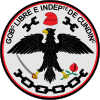Departamento de Cundinamarca
| Data | |
|---|---|
| Capital | Bogotá |
| governor | Nicolás García Bustos (2020-2023) |
| surface | 22,623 km² |
|
Population (Total) - 2005 Census - Population Density |
2,280,037 without Bogotá 94 inhabitants / km² |
| urbanization | 54% |
| Literacy rate | 88% |
| Number of parishes | 116 |
| Popular name | cundinamarqués |
| Important cities | Soacha , Facatativá , Girardot , Zipaquirá |
| map | |
| Location of Cundinamarca in Colombia | |
The Departamento de Cundinamarca is a department in central Colombia . It almost completely encloses the capital city of Bogotá, Distrito Capital . The Boyacá department borders in the northeast, Meta and Huila are in the south and Tolima and Caldas to the west .
overview
Mainly potatoes , onions , coffee and sugar cane are grown. Cundinamarca is also an important producer of milk . The region is rich in natural resources. There are coal, iron, salt, limestone, emerald and quartz deposits. Cundinamarca is the industrial heart of Colombia. Factories for the food and beverage industry, textile processing, machine and equipment construction, the chemical and petroleum processing industry, metal processing and paper production are located here.
Before it was conquered by the Spaniards, Cundinamarca was the center of the Chibcha , who had established an important empire between the Inca and Central American cultures. In the high-lying lakes of Cundinamarca, their kings, which were completely covered with gold dust, sacrificed gold and emeralds to the gods, and the legend of Eldorado ('the gilded') was born.
Cundinamarca is the 'Land of the Condor ' and is located in the mountains of the Andean Cordillera.
The current name is a deformation of the Chibcha kuntur marqa . When the Spanish conquerors arrived in the area and heard the two words, they interpreted them as Cundirumarca which eventually became known as Cundinamarca, which would mean the county or province of the condor in Spanish.
The salt cathedral in Zipaquirá is worth seeing .
geography
The department of Cundinamarca surrounds the Colombian capital Bogotá and includes the entire area of the Sabana de Bogotá , a plateau about 2600 m high. The eastern border to the Meta Department runs roughly along the main ridge of the Eastern Cordillera, the western and southern borders along the Sumapaz and Magdalena rivers . The highest mountains clearly exceed the 3,000 m limit.
The climate fluctuates due to the great differences in altitude (Bogotá approx. 2600 m, Girardot approx. 200 m), but is generally rich in precipitation due to the western exposure of the mountain slopes.
history
Until the arrival of the Spaniards, the region of the Sabana de Bogotá was the area of the Muisca high culture, which has inhabited the area around today's Bogotá since around 1100 AD. Representatives of the Panche culture lived on the western slope of the Eastern Cordillera . The Muisca are best known for the legend of El Dorado .
The European settlement begins with the meeting of Nikolaus Federmann and Gonzalo Jiménez de Quesada on the plateau of Bogotá and the joint establishment of the settlement of the same name in the year 1538. After that, the settlement initially concentrated on the western part of Cundinamarca, since the Río Magdalena as a traffic route to the sea and thus to Europe gained great importance. So already in the 16th century z. B. the cities of Tocaima and Anolaima as stops on the arduous way from the banks of the Magdalena up to Bogotá.
Administrative division
The 116 municipalities of Cundinamarca are in the list of Municipios in the Departamento de Cundinamarca .
Web links
Individual evidence
- ↑ ¿Qué significa el nombre 'Cundinamarca'? girardot.info, accessed April 17, 2018 (Spanish)



